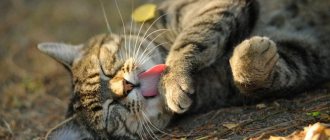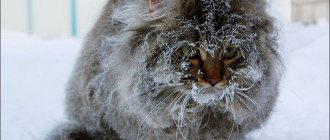Olfactory organ in cats
Two organs are responsible for the sense of smell in cats - the olfactory epithelium and Jacobson's organ (vomeronasal, vomeronasal), which, together with the olfactory nerves and olfactory centers in the cerebral cortex, form the olfactory analyzer.
• The olfactory fissure is a small opening in the nasal passage that connects it to the olfactory region of the nasal cavity. It can open and close due to the dilation or constriction of blood vessels.
• Olfactory turbinates are thin bony lobes covered with olfactory epithelium, located in the upper posterior part of the nasal cavity (olfactory cavity).
• Olfactory epithelium - an epithelium consisting of receptor cells covered with cilia (perceiving smell), supporting cells (secreting protective mucus) and basal cells (providing the formation of new neurons).
• Jacobson's organ - two thin tubules located behind the olfactory region and opening into the oral cavity with two openings behind the incisors. The tubules are lined with epithelium, similar in structure to the olfactory epithelium, but perceiving other odors using other proteins.
Mechanisms
Hearing of felines
So that the cat can pick up high-frequency sounds, their hearing aid is adapted. In relation to the head area, the ears are quite large. The organs quickly move in different directions, thanks to this the animal easily detects the direction and the source. The ears have a special shape, which allows even the most distant sounds to enter the canal. Cats are also able to distinguish sounds that differ by half a tone. With the help of this sense, the predator determines the type and size of the prey.
Features of vision
A cat's pupil tends to dilate depending on the lighting, which helps the animal see at night.
Tailed pets see well at night. They are able to distinguish objects in poor lighting, but cannot see in pitch darkness. The retina of a cat's eye has 2 types of cells. The former are capable of perceiving horizontal elements, the latter - vertical objects. A cat's eyes function by detecting movement. And they distinguish particularly fast movements of objects, but they perceive slower moving figures less well. Thanks to their ability to dilate their pupils, cats can see in dark places. The nictitating membrane, also called the third eyelid, cleans and further protects the animal’s visual organs.
The importance of smell in cats
Cats trust their sense of smell. Before eating, they always smell the food. They prefer to leave marks of their scent on the territory. Thanks to their sense of smell, animals are able to find food and also distinguish enemies from friends. The vomeronasal organs analyze airborne molecules. Using the peripheral part of the olfactory system, cats and some other animals can predict earthquakes. Jacobson's organs carry out searches for food, sexual hunting, and also perceive pheromones.
Orientation in space
Scientific research involving biologists and veterinary professors has proven that cats can navigate using the Earth's magnetic field. They are also helped in spatial orientation by especially developed organs and senses. Among them are:
- sensitive hearing;
- acute vision;
- good sense of smell.
Vestibular apparatus
A well-developed vestibular apparatus allows the pet not only to walk on thin objects, but also to land on its paws when falling.
The coordination of movements in the cat family is very developed. Animals can move accurately and quickly on thin objects thanks to the well-functioning vestibular system. It is located in the area of the inner ear. When falling, cats are able to land on their feet. The stabilizer in such situations is the tail with the help of the necessary movements.
The reaction of placing the limbs to the sides is also considered an important reflex.
As a result of such a fall, the sliding area through the air increases. This results in a “parachute effect”. However, when falling from a window at a great height, the cat may be in a state of shock, and in this case the reflexes do not work. The same outcome is possible during a flight from minimal altitudes, but in this case the reason is the lack of time to turn over.
The process of smell in cats
When air is inhaled through the nose, the odorous substance penetrates through the olfactory fissure into the olfactory region, where, apparently, it dissolves in mucus, and in this form comes into contact with receptor cilia. Receptors along the olfactory nerve transmit the learned signals to the olfactory bulb in the cerebral cortex.
When inhaling air through the mouth or when licking a surface in order to perceive the smell, the cat lifts its upper lip, exposing its teeth, and pulls its lips back (as if smiling), and opens its mouth for better inhalation. This reaction is called “flehmen” and ensures the penetration of odorous substances into the Jacobson's organ. The Jacobson's organ is connected by a separate nerve to a separate olfactory bulb in the cerebral cortex.
Sometimes odorous substances can be perceived by the receptors of the olfactory epithelium from the blood through the vessels of the olfactory region. This happens when certain substances are administered intravenously.
Anatomy and physiology of a cat
Contents of the material
- Anatomy and physiology of a cat
- Cat skeleton
- Cat skin
- Nervous system of a cat
- Cat's sense organs
- Cat digestive system
- Reproductive organs of cats
- All pages
Page 1 of 7
Basic physiological indicators of cats.
Cats of different breeds are different from each other. But their basic parameters are the same. They generally weigh from three to seven kilograms. Although, they can have more or less weight.
A cat's normal temperature is higher than that of humans, about 38-39 degrees. And kittens can be about forty. A cold nose in a cat, just like a cold nose in a dog, is a sign that your friend is healthy. And, by the way, a cat’s nose is the same “fingerprint” as a human’s. The pattern of the surface of the nose is unique. But you shouldn’t always rely on a cat’s nose - if you suspect an illness, it’s better to measure the temperature with a thermometer.
You can measure your cat's pulse if you press on the inside of the thigh. In normal condition, there are 100-150 beats per minute. And in kittens, the pulse, as well as the temperature and breathing rate, is much higher than that of adult cats.
The lifespan of cats is often exaggerated, but many cases are reliably known when they lived up to 20 years. However, the normal lifespan of a cat is 10-15 years.
A cat's pregnancy lasts 59-69 days. Kittens are born helpless and blind.
Hierarchical relationships are established between cats living together, the nature of which depends on the habitat and type of activity of the animals.
Stati, or body parts
From an anatomical point of view, the development of a cat is at a high level. Due to the fact that it was domesticated much later than, say, the dog or other animals, the cat retained almost the same anatomical structure as other representatives of the feline family. The individual parts of the cat's body are mutually proportional, which allows it to be mobile without losing its elegance.
Let us conditionally divide the cat’s body into 4 parts (Fig. 1).
1. Head. It distinguishes between the brain (skull) and facial (muzzle) parts. The facial part also includes the forehead, nose, ears, and teeth.
2. Neck. Here the upper part and the lower region are distinguished.
3. Torso. It is represented by the withers, which are formed by the first five thoracic vertebrae and the upper edges of the scapula, which are on the same level with them, the back, lower back, thoracic region (chest), croup, groin region, abdomen, mammary gland and prepuce region, anal region, tail.
Rice. 1. Cat body parts: 1 – nose; 2 – nose; 3 – forehead; 4 – ear; 5 – parietal part of the head; 6 – neck; 7 – withers; 8 – scruff; 9 – ridge; 10 – tail root; 11 – tail; 12 – upper jaw and upper lip; 13 – cheeks; 14 – chin and lower jaw; 15 – lateral part of the neck; 16 – chest; 17 – shoulder; 18 – lateral part of the chest; 19 – sides; 20 – stomach; 21 – groin; 22 – croup; 23 – forelimbs; 24 – hind limbs; 25 – paws
4. Limbs – thoracic (front): shoulder, elbow, forearm, wrist, metacarpus and pelvic (back): thigh, knee, lower leg, heel, metatarsus.
The cat's appearance, physique and characteristics of individual parts of its body, characteristic of its breed and gender, are called exterior. General exterior examines the physique, the structure of individual parts of the body, their most characteristic deviations and defects; the particular one examines the structural features of individual breeds, typical and atypical features for them.
The term “constitution” combines all the properties of an animal’s body: features of its anatomical structure, physiological processes, including features of nervous activity that determine reactions to the external environment.
Cat breeds differ little in the size and proportions of individual body parts. Therefore, within one species, unlike dogs, we are faced with a certain unification of organs and body parts.
Movement apparatus, or musculoskeletal system of a cat
The movement apparatus is represented by the skeleton, ligaments and muscles, which, unlike other systems, form the cat’s physique and appearance. To imagine its significance, it is enough to know that in newborn animals the movement apparatus accounts for approximately 70–78% of body weight, and in adults – up to 60–68%. In phylogenesis, sections of different importance are formed: the skeleton as a supporting structure, ligaments that connect bones and skeletal muscles that move bone levers.
The owner of a cat has to deal with disturbances in the skeleton of his pet, its underdevelopment, decreased strength, lack or excess of mineral saturation (softness or fragility of bones), disruption of its internal structures, leading not only to bone disease, but also to disease of the body as a whole. Thus, the mineral composition of the bone is affected not only by the state of the organic (osteoid) part of the bone, but also by feeding in combination with physical activity. The absence of the latter leads to the rapid removal of calcium salts from the body, which must be taken into account during pregnancy of animals.
The bones in the skeleton are divided by shape into four main types: short, flat (scapula, ribs, pelvic bones, skull bones), mixed (vertebra), long tubular bones (limb bones) and consist of 6 components, one of which is the red bone The brain is a hematopoietic organ. In a newborn animal, all bones are hematopoietic, but during the first 2 months after birth, the red marrow becomes yellow bone marrow. Red bone marrow is stored longest in the spongy substance of the sternum and vertebral bodies.
- Forward
"Scent of Passion"
Scientists never stop searching for that secret ingredient that will pave the way to a partner’s heart and be able to maintain a romantic relationship. You won’t surprise anyone with perfume products containing pheromones. Many companies and corporations declare their products as containing pheromones and having the properties of attracting people of the opposite sex. The secret of production and composition of perfumes are kept in the strictest confidence. And you may not believe in the effectiveness of synthetic pheromones, but the facts speak for themselves.
Vomeronasal organ and partner choice
Exposure through the subconscious explains the impossibility of controlling jealousy, attraction, and the torment of unrequited love and passion. Human skin, and especially the nasolabial folds and armpits, is a whole factory of pheromones. They are almost odorless, but it is they who, through vomeronasal perception, determine the sexual attractiveness of a partner and decide who is attractive to us and who is not at all. It is sex pheromones that are responsible for love at first sight, or rather, at first smell. The study of the effects of pheromones on humans began in the 1990s, but today there is real evidence about their role in the formation of sexual behavior. Pheromones have been discovered that create sexual hostility towards close relatives and prevent incest. The pheromones produced by the mother's nipple have been identified, and the baby knows exactly where the milk is and whether it is his mother's. There are pheromones that calm, lower blood pressure and reduce heartbeat.
A remedy for romance
The effect of synthetic hormones was clearly demonstrated by the experiment of psychology professor Norma McCoy from the University of San Francisco. 30 representatives of the fair sex aged 19 to 48 were offered to try out a remedy that would make life more romantic. Every day, the test and control (placebo) groups added a drop of the resulting substance to their perfume. After three menstrual cycles, the results were summed up. In 74% of participants who used synthetic pheromones, sexual activity increased, while in the control group this figure was 24%.
And yet, synthetic pheromones are just a temporary veil under which our essence is hidden. And even in experiments with animals, sexual behavior arose not only in response to the spraying of pheromones, but also in the presence of individuals of the opposite sex. In addition, the “sixth sense” is the sixth sense because when choosing a partner, we rely not only on him, but also on the other five of our senses. Look for a partner using synthetic pheromones or rely on existing reality - the choice is yours.
Plant and animal pheromones
Modern biology understands this concept as a group of volatile chemical compounds that are secreted by plants and animals to provide communication, signaling and sexual stimulation. Pheromones carry not only sexual meaning, although this part of their action is the most mysterious and interesting. In terms of their meaning, they can be territorial (animals mark the territory), guiding (ants show the way to their fellows), repellent (plants release signal substances when attacked by pests) and many others. The first pure pheromone was isolated in 1956 and was a powerful attractant of the silkworm butterfly - it caused the males to beat their wings in a “fluttering dance” in the most minimal doses. It is believed that if one female butterfly releases the entire supply of this pheromone at once, she can attract a trillion males. Since there are pheromones, there must be a system for their perception.
Romance with pheromones
It all started in 1870, when French biologist Jean-Henri Casimir Fabre (1823-1915) briefly left a butterfly in his laboratory. Returning to the laboratory, he saw that several male butterflies had gathered near the window. And no matter what room he moved the female to, the males inseparably followed her. This is how the concept of “attractants” appeared in biology - substances that are secreted by a female to attract males. Only in 1959, having accumulated sufficient knowledge about volatile substances and their role in reproductive behavior, the Swiss entomologist Martin Lüscher (1917-1979) introduced the concept of “pheromone” (pheromone), as a term derived from the merger of the Greek words “to carry” and “ stimulate."
Mother-child system
The role of vomeronasal smell in the relationship between a mother and her baby has been proven in animal experiments. Baby mammals secrete specific pheromones that stimulate the expression of maternal instincts in the female. Removal of the vomeronasal organ in females leads to a sharp suppression of maternal behavior. There is a theory that sexual disorders and homosexual preferences in people can cause disruptions in the level of sex hormones during pregnancy. This area of work of the vomeronasal olfactory system has not yet been studied enough and is fraught with many discoveries.
Cat paw pads
A cat receives most of its sensory information from its paw pads. Cats' paws have sensitive tactile receptors. This allows the cat to obtain information about the object's temperature, surface, configuration and structure. When exploring an object, the cat can lightly touch it, after which it does it more confidently, and then puts its entire paw on it, and after that it can simply hold the object between its paws and sniff. Everyone has seen the picture of a cat shaking off its paw after stepping in water or mud. The cat receives information about this from tactile receptors. Also, a cat's paw pads have pressure receptors (baroreceptors), this allows the cat to sense vibration and most likely plays a huge role in the cat's unique sense of balance. Also, the paw pads are the place where a large number of sweat glands are concentrated; there are no sweat glands on the cat’s body (they are also present in the area of the genitals and anus).











